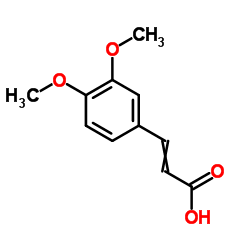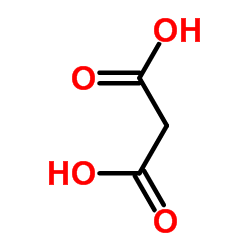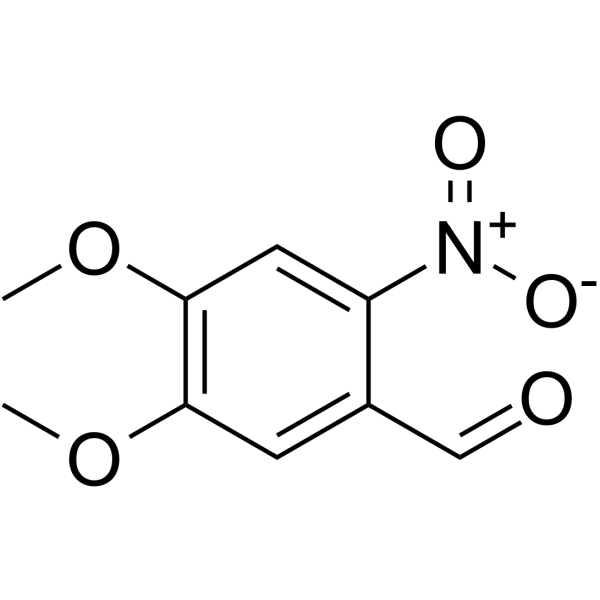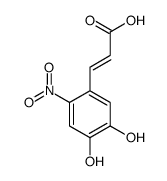20567-38-8
| Name | 4,5-dimethoxy-2-nitrocinnamic acid |
|---|---|
| Synonyms |
4,5-Dimethoxy-2-nitrociamic acid
6-Nitro-3.4-dimethoxy-trans-zimtsaeure 4,5-Dimethoxy-2-nitrocinnamic acid 3-(4,5-DIMETHOXY-2-NITROPHENYL)ACRYLIC ACID 6-nitro-3.4-dimethoxy-trans-cinnamic acid 2-Nitro-4,5-dimethoxy-trans-cinnamic acid 6-nitro-3,4-dimethoxycinnamic acid RARECHEM BK HW 0176 2-nitro-4,5-dimethoxycinnamic acid 3,4-DIMETHOXY-6-NITROCINNAMIC ACID MFCD00017017 |
| Density | 1.369g/cm3 |
|---|---|
| Boiling Point | 482.9ºC at 760mmHg |
| Melting Point | 293 °C (dec.)(lit.) |
| Molecular Formula | C11H11NO6 |
| Molecular Weight | 253.20800 |
| Flash Point | 245.8ºC |
| Exact Mass | 253.05900 |
| PSA | 101.58000 |
| LogP | 2.23300 |
| Vapour Pressure | 3.9E-10mmHg at 25°C |
| Index of Refraction | 1.604 |
Synonym:3-(4,5-Dimethoxy-2-Nitrophenyl)acrylic Acid Section 2 - COMPOSITION, INFORMATION ON INGREDIENTS
Risk Phrases: None Listed. Section 3 - HAZARDS IDENTIFICATION EMERGENCY OVERVIEW
The toxicological properties of this material have not been fully investigated. Potential Health Effects Eye: May cause eye irritation. Skin: May cause skin irritation. Ingestion: May cause irritation of the digestive tract. The toxicological properties of this substance have not been fully investigated. Inhalation: May cause respiratory tract irritation. The toxicological properties of this substance have not been fully investigated. Chronic: No information found. Section 4 - FIRST AID MEASURES Eyes: Flush eyes with plenty of water for at least 15 minutes, occasionally lifting the upper and lower eyelids. Get medical aid. Skin: Get medical aid. Flush skin with plenty of water for at least 15 minutes while removing contaminated clothing and shoes. Wash clothing before reuse. Ingestion: Never give anything by mouth to an unconscious person. Get medical aid. Do NOT induce vomiting. If conscious and alert, rinse mouth and drink 2-4 cupfuls of milk or water. Wash mouth out with water. Inhalation: Remove from exposure and move to fresh air immediately. If not breathing, give artificial respiration. If breathing is difficult, give oxygen. Get medical aid. Notes to Physician: Section 5 - FIRE FIGHTING MEASURES General Information: As in any fire, wear a self-contained breathing apparatus in pressure-demand, MSHA/NIOSH (approved or equivalent), and full protective gear. During a fire, irritating and highly toxic gases may be generated by thermal decomposition or combustion. Extinguishing Media: Use agent most appropriate to extinguish fire. Use water spray, dry chemical, carbon dioxide, or appropriate foam. Section 6 - ACCIDENTAL RELEASE MEASURES General Information: Use proper personal protective equipment as indicated in Section 8. Spills/Leaks: Vacuum or sweep up material and place into a suitable disposal container. Clean up spills immediately, observing precautions in the Protective Equipment section. Avoid generating dusty conditions. Provide ventilation. Section 7 - HANDLING and STORAGE Handling: Wash thoroughly after handling. Use with adequate ventilation. Minimize dust generation and accumulation. Avoid contact with eyes, skin, and clothing. Keep container tightly closed. Avoid ingestion and inhalation. Storage: Store in a tightly closed container. Store in a cool, dry, well-ventilated area away from incompatible substances. Section 8 - EXPOSURE CONTROLS, PERSONAL PROTECTION Engineering Controls: Facilities storing or utilizing this material should be equipped with an eyewash facility and a safety shower. Use adequate ventilation to keep airborne concentrations low. Exposure Limits CAS# 20567-38-8: Personal Protective Equipment Eyes: Wear appropriate protective eyeglasses or chemical safety goggles as described by OSHA's eye and face protection regulations in 29 CFR 1910.133 or European Standard EN166. Skin: Wear appropriate protective gloves to prevent skin exposure. Clothing: Wear appropriate protective clothing to prevent skin exposure. Respirators: A respiratory protection program that meets OSHA's 29 CFR 1910.134 and ANSI Z88.2 requirements or European Standard EN 149 must be followed whenever workplace conditions warrant respirator use. Section 9 - PHYSICAL AND CHEMICAL PROPERTIES Physical State: Solid Color: Not available. Odor: Not available. pH: Not available. Vapor Pressure: Not available. Viscosity: Not available. Boiling Point: Not available. Freezing/Melting Point: > 270 deg C Autoignition Temperature: Not applicable. Flash Point: Not applicable. Explosion Limits, lower: Not available. Explosion Limits, upper: Not available. Decomposition Temperature: Solubility in water: Specific Gravity/Density: Molecular Formula: C11H11NO6 Molecular Weight: 253.21 Section 10 - STABILITY AND REACTIVITY Chemical Stability: Stable at room temperature in closed containers under normal storage and handling conditions. Conditions to Avoid: Incompatible materials, dust generation, excess heat. Incompatibilities with Other Materials: Oxidizing agents. Hazardous Decomposition Products: Nitrogen oxides, carbon monoxide, irritating and toxic fumes and gases, carbon dioxide. Hazardous Polymerization: Has not been reported Section 11 - TOXICOLOGICAL INFORMATION RTECS#: CAS# 20567-38-8 unlisted. LD50/LC50: Not available. Carcinogenicity: 4,5-Dimethoxy-2-Nitrocinnamic Acid - Not listed by ACGIH, IARC, or NTP. Section 12 - ECOLOGICAL INFORMATION Section 13 - DISPOSAL CONSIDERATIONS Dispose of in a manner consistent with federal, state, and local regulations. Section 14 - TRANSPORT INFORMATION IATA Not regulated as a hazardous material. IMO Not regulated as a hazardous material. RID/ADR Not regulated as a hazardous material. Section 15 - REGULATORY INFORMATION European/International Regulations European Labeling in Accordance with EC Directives Hazard Symbols: Not available. Risk Phrases: Safety Phrases: S 24/25 Avoid contact with skin and eyes. S 28A After contact with skin, wash immediately with plenty of water. S 37 Wear suitable gloves. S 45 In case of accident or if you feel unwell, seek medical advice immediately (show the label where possible). WGK (Water Danger/Protection) CAS# 20567-38-8: No information available. Canada None of the chemicals in this product are listed on the DSL/NDSL list. CAS# 20567-38-8 is not listed on Canada's Ingredient Disclosure List. US FEDERAL TSCA CAS# 20567-38-8 is not listed on the TSCA inventory. It is for research and development use only. SECTION 16 - ADDITIONAL INFORMATION N/A |
| Personal Protective Equipment | Eyeshields;Gloves;type N95 (US);type P1 (EN143) respirator filter |
|---|---|
| Safety Phrases | S24/25 |
| RIDADR | NONH for all modes of transport |
| WGK Germany | 3 |
| HS Code | 2918990090 |
|
~0% 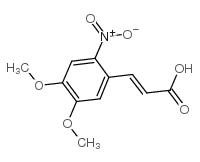
20567-38-8 |
| Literature: Peterson, John R.; Do, Hoang D.; Dunham, Andrew J. Canadian Journal of Chemistry, 1988 , vol. 66, p. 1670 - 1674 |
|
~% 
20567-38-8 |
| Literature: Archiv der Pharmazie (Weinheim, Germany), , vol. 272, p. 770,774 |
|
~% 
20567-38-8 |
| Literature: Yakugaku Zasshi, , vol. 58, p. 402;engl.Ref.S.80 Chem.Abstr., , p. 6650 |
|
~% 
20567-38-8 |
| Literature: Yakugaku Zasshi, , vol. 58, p. 402;engl.Ref.S.80 Chem.Abstr., , p. 6650 |
| Precursor 5 | |
|---|---|
| DownStream 2 | |
| HS Code | 2918990090 |
|---|---|
| Summary | 2918990090. other carboxylic acids with additional oxygen function and their anhydrides, halides, peroxides and peroxyacids; their halogenated, sulphonated, nitrated or nitrosated derivatives. VAT:17.0%. Tax rebate rate:13.0%. . MFN tariff:6.5%. General tariff:30.0% |
